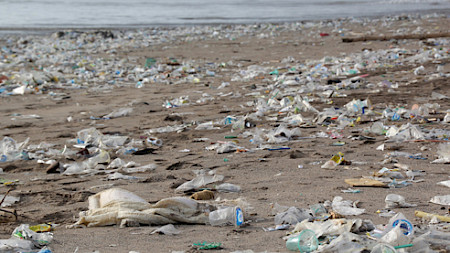20.11.2025, 09:33 Uhr
Laut dem «Natixis Institutional Investor Outlook 2026» bestätige die Schweiz ihre Führungsposition im Bereich Krypto und private Märkte. 70 Prozent der Schweizer Institutionellen rechnen zudem mit einer...


Seema Suchak and Elly Irving, Sustainable Investment Analysts at Schroders, look at some of the potential winners and losers from the war on plastic.
The use of plastics has come under intense scrutiny in recent months. Prompted by headlines like "More plastic than fish in the oceans by 2050" and "UN commits to stop ocean plastic waste", consumers and regulators have turned their attention to an issue that has escaped mainstream focus until recently. Concerns regarding plastics are well past a tipping point of public concern and regulatory action.
Plastics manufacturers most at risk
The impacts to date have been relatively modest and focused on narrow areas. While individual plastic products have found themselves in the limelight, the issue spreads much further than carrier bags, micro beads or straws. Seema Suchak and Elly Irving apply a broader lens to the wider plastics landscape, assessing the areas of consumer packaging likely to face the most pressure, the companies that supply those products and the raw materials they contain.
While consumer companies have been most visibly affected by the increased attention, the impacts elsewhere in plastics value chains among packaging companies and raw material suppliers are likely to be more intense and disruptive. Suchak and Irving have looked through that value chain to assess potential risks, the companies exposed to them and the steps some leaders are taking. The Sustainable Investment Analysts expect the biggest impacts to be felt by manufacturers of plastic packaging.
Consumer companies are willing to change
Consumer companies will need to reduce plastics use by substituting single use plastics for alternative materials or redesigning or reducing packaging. A long list of companies has already announced plans to change their approaches to packaging use. For instance, Costa Coffee owner Whitbread has launched a nationwide recycling scheme, Coca-Cola has committed to collect and recycle the equivalent of all its packaging in Western Europe by 2030 and McDonalds plans to make all of its packaging renewable or recyclable by 2025. There will be costs to retooling equipment, reconfiguring supply chains and in some cases higher materials costs. However, Suchak and Irving's analysis shows that companies already adapting to these trends may benefit. Cost savings achieved by lower packaging use, improved consumer perceptions and reduced regulatory risks could contribute to higher margins for food producers and household & personal product companies. The experts find that soft drinks companies carrying on with business-as-usual face the biggest downside risks.
Packaging companies face bigger challenges
Currently, 37% of consumer packaging is plastic, the outlook for which is clearly challenged. On the other hand, leaders that are able to develop sustainable alternatives like bioplastics or improved recyclability will emerge from these challenges stronger. They should be able to establish distinctive products for which they have pricing leverage, replacing their current reliance on traditional commodity plastics categories. While some major players are already directing their innovation efforts to developing more sustainable packaging, Suchak and Irving believe that innovation is too slow to allow the industry as a whole to pivot away from traditional plastics undamaged. Their analysis of the operating profit exposures of individual packaging companies highlights the value of leadership, with well-placed companies suffering little impact and laggards seeing up to one-third of earnings at risk.
Chemicals companies feel the pressure
Chemicals companies are starting to develop compostable, bio-based plastics as well as different types of polymers that can achieve reductions in material use. Bioplastics and compostable materials are starting to gain traction. The bioplastic market is set to grow at a 30% compound annual growth rate to 2030 (from 2013), compared to an average of 3% growth for fossil-based plastic. They have their flaws: they can be hard to recycle, more expensive to make, and not yet available in large quantities, but improvements in cellulose conversion technology are expected to enhance the quality, quantity and cost. As manufacturers face pressure from their consumer-facing customers, the more innovative companies should gain market share. Most of those beneficiaries appear likely to emerge from the current industry leaders.
Waste utility and recycling companies benefit
Waste utility and recycling companies are likely to benefit from growing demand for end-of-life recycling and reuse. Recent Chinese waste import restrictions, coupled with increased political and regulatory pressure on plastic waste, create a potential springboard for the recycling industry. New geographies, new applications and new products could lead to market growth of 7-9%. Picking out winners from a fragmented, highly competitive industry is challenging and the experts think localised solutions will be key.
Impact on oil production will be modest
Oil is the main raw material used in plastics production. However, 4-8% of global oil production is used to make plastic, of which an estimated half is used for packaging. As a result, the impact on that market is likely to be modest, although the issue unhelpfully compounds the wider challenges facing the energy sector.
Single use plastics have become ubiquitous in today's consumer product industries and value chains. Suchak and Irving expect pressures to spread from the specific niches on which attention has focused so far, to the wider range of products contributing to a global environmental challenge that has begun to move from ecological concern to economic drive